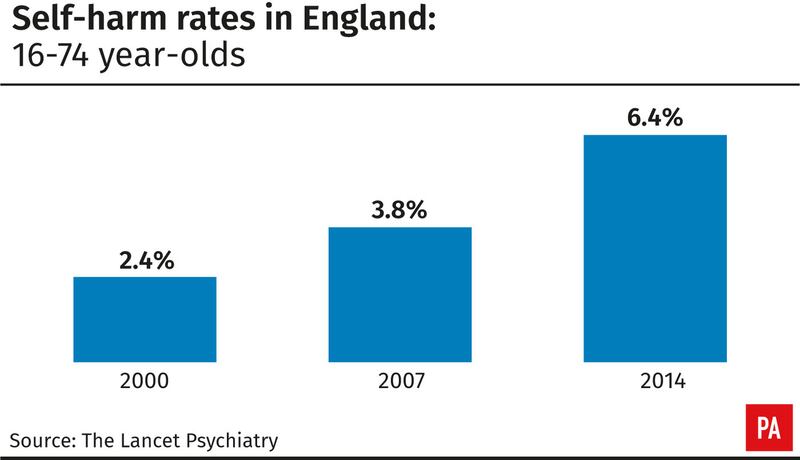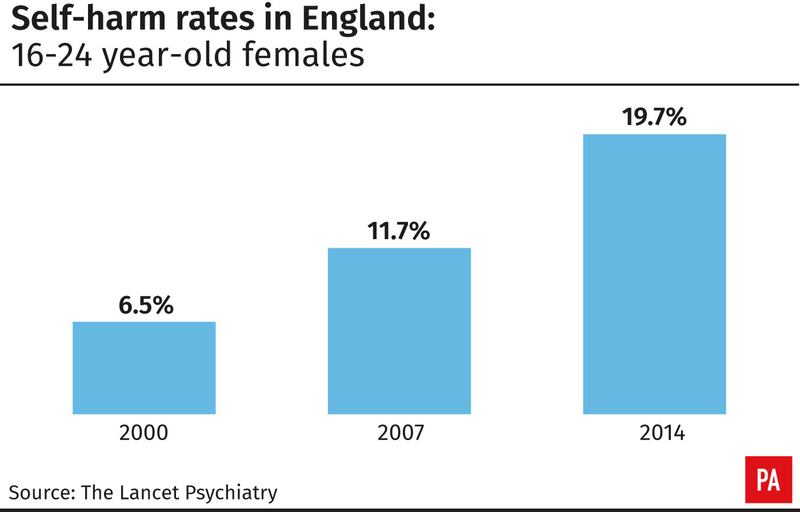Rates of self-harm have risen in England, particularly among girls and young women, research suggests.
In 2014, 6.4% of 16 to 74-year-olds reported having intentionally harmed themselves at some point in their life, up from 2.4% in 2000, according to a study published in The Lancet Psychiatry.

The rate was highest among girls and women aged 16 to 24, with one in five (19.7%) reporting self-harm.
Emma Thomas, chief executive of charity YoungMinds, described the figures as “alarming”.
The study provides the first evidence of long-term trends in non-suicidal self-harm in England, the researchers said.
Lead author Sally McManus, from the National Centre for Social Research, said: “Non-suicidal self-harm is increasingly being reported as a way of coping. We need to help people, especially young people, learn more appropriate and effective ways of dealing with emotional stress.
“The availability of services needs to be improved, especially for young people, so that health, education and social care professionals can discuss the subject with them and support better emotional health.”
If you're struggling to cope tonight, or any time, we're here. pic.twitter.com/4UA262BGK1
— Samaritans (@samaritans) May 31, 2019
Previous studies have used data from health services to measure self-harm, but many people who self-harm do not seek or receive help, the researchers said.
They analysed responses from people aged 16 to 74 in England in 2000, 2007 and 2014, mainly using information from face-to-face interviews.
Their sample included 7,243 people in 2000, 6,444 in 2007 and 6,477 in 2014.
Across the period, the rate of lifetime non-suicidal self-harm rose from 2.4% to 3.8% to 6.4% across the population.
In 2000 and 2007, prevalence was similar between the sexes, but by 2014 it had become higher in women and girls (7.9%) than men and boys (5%).
Among 16 to 24-year-old girls and women in 2014, 19.7% reported having self-harmed at some point in their life.
This compared with 6.5% in 2000 and 11.7% in 2007.

The increase was mainly because of rises in self-cutting and use of self-harm to relieve unpleasant feelings, the authors said.
Despite rising rates of self-harm, the researchers said they did not find evidence of an increase in people seeking treatment.
The proportion of people who said they had no contact with medical or psychological services after self-harming was 51.2% in 2000, 51.8% in 2007 and 59.4% in 2014.
“The rise in rates of self-harm – particularly among girls and young women – is alarming,” Ms Thomas said.
“At the moment, it’s far too difficult for children and young people to get mental health support before they reach crisis point.
“The Government has promised extra investment, which must make a real difference to frontline services – but we also need to see action so young people can get early support in their communities.”
Jacqui Morrissey, assistant director of research and influencing at Samaritans, said: “Self-harm is a sign of serious emotional distress and while the majority of people who self-harm will not go on to take their own life, it is a strong predictor for future suicide risk.
“It’s therefore vital that there is a broad public health approach, rooted in education across frontline professionals and the wider community, improved mental health services and effective support on and offline.”








